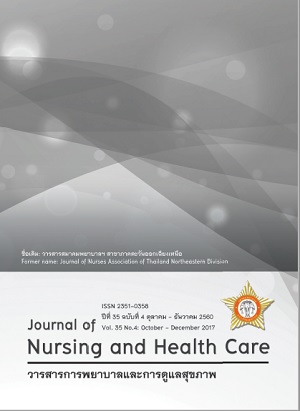อุบัติการณ์การเกิดภาวะแทรกซ้อนหลังผ่าตัด การจัดการและผลลัพธ์ทางการพยาบาล ของผู้ป่วยในห้องพักฟื้น Incidence of Post-operative Complications, Nursing Management and Outcomes in Patients at Post Anesthesia Care Unit (PACU)
คำสำคัญ:
อุบัติการณ์ภาวะแทรกซ้อน การจัดการทางการพยาบาลหลังผ่าตัด ผลลัพธ์ทางการพยาบาลหลังผ่าตัด ห้องพักฟื้น, incidence of post-operative complications post-operative nursing management post-operative nursing outcome post-anesthesia care unit (PACU)บทคัดย่อ
การวิจัยแบบศึกษาย้อนหลังนี้มีวัตถุประสงค์เพื่อ 1) ศึกษาภาวะแทรกซ้อนหลังผ่าตัดในห้องพักฟื้น การจัดการทางการพยาบาลและผลลัพธ์ทางการพยาบาลเมื่อเกิดภาวะแทรกซ้อน และ2) วิเคราะห์ปัจจัยทำนายภาวะแทรกซ้อน คำนวณขนาดตัวอย่างโดยใช้สูตรของ Yamane จำนวน 495 ราย เกณฑ์คัดเข้า คือ 1) แฟ้มประวัติผู้ป่วยทั้งเพศชายและเพศหญิง 2) อายุ 15 ปีขึ้นไป 3) รับการผ่าตัดที่โรงพยาบาลมหาวิทยาลัยเทคโนโลยีสุรนารีทั้งแบบเร่งด่วนและไม่เร่งด่วน ระหว่าง พฤษภาคม – สิงหาคม 2558 เครื่องมือที่ใช้เป็นแบบบันทึกข้อมูลที่ผู้วิจัยสร้างขึ้น เก็บรวบรวมข้อมูลจากแฟ้มประวัติผู้ป่วย วิเคราะห์ความสัมพันธ์ของข้อมูลส่วนบุคคลกับอุบัติการณ์โดยใช้สถิติ Chi-square test, Fisher’s exact test หรือ F-test วิเคราะห์ปัจจัยทำนายด้วยการวิเคราะห์ Binary logistic regression ผลการวิจัย พบอุบัติการณ์ภาวะแทรกซ้อนหลังผ่าตัด ร้อยละ 38.8 ตามลำดับดังนี้ 1) ปวด พบร้อยละ 28.1 โดยค่าเฉลี่ย คะแนนอาการปวดอยู่ในระดับปานกลาง (mean 6.53±0.19) การจัดการทางการพยาบาลมีทั้งแบบใช้ยาและไม่ใช้ยา ผลลัพธ์ คือ คะแนนอาการปวดอยู่ในระดับเล็กน้อย (mean 3.58±0.18) ก่อนย้ายกลับหอผู้ป่วย 2) อาการหนาวสั่น ร้อยละ 9.5 การจัดการทางการพยาบาลโดยดูแลโดยห่มผ้าห่มไอร้อน ให้ยาและสังเกตอาการ ผลลัพธ์ คือ อาการหมดไปก่อนย้ายผู้ป่วยออกจากห้องพักฟื้น และ 3) อาการคลื่นไส้อาเจียน พบ ร้อยละ 1.2 การจัดการทางการพยาบาลโดยใช้ยาลดคลื่นไส้อาเจียนและสังเกตอาการ ผลลัพธ์ คือ อาการหมดไปก่อนย้ายผู้ป่วยออกจากห้องพักฟื้น ปัจจัยทำนายอาการปวดอย่างมีนัยสำคัญทางสถิติที่ระดับ 0.05 ได้แก่ การผ่าตัดทางสูตินรีเวช (OR 22.76) การผ่าตัดหู คอ จมูก (OR 5.46) การผ่าตัดทางเดินปัสสาวะ (OR 3.34) ระยะเวลาระงับความรู้สึกน้อยกว่า 60 นาที (OR 8.04) 60 – 120 นาที (OR 5.43) ระยะเวลาผ่าตัด 60 -120 นาที (OR 6.41) การผ่าตัดแบบไม่เร่งด่วน (OR 3.57) โดยร่วมทำนายได้ร้อยละ 46.1และทำนายได้ถูกต้องร้อยละ 81 ปัจจัยทำนายอาการหนาวสั่นอย่างมีนัยสำคัญทางสถิติที่ระดับ 0.05 ได้แก่ ระยะเวลาระงับความรู้สึกน้อยกว่า 60 นาที (OR 3.87) และ การใช้ยาระงับความรู้สึกแบบทั่วร่างกาย (OR 2.60) โดยร่วมทำนายได้ร้อยละ 28.1 และทำนายได้ถูกต้องร้อยละ 89.9
ผลการศึกษาให้ข้อเสนอแนะในการพัฒนาแนวปฏิบัติทางการพยาบาลเพื่อเฝ้าระวังและลดความปวดหลังผ่าตัด โดยเฉพาะในการผ่าตัดทางสูตินรีเวช และอาการหนาวสั่นในผู้ป่วยที่ได้ยาระงับความรู้สึกแบบทั่วร่างกายน้อยกว่า 60 นาที
This retrospective aimed to, 1) assess the incidence of postoperative complications (POCs), nursing management and clinical nursing outcome in post-anesthesia care unit (PACU) and 2) analysis factors for predicting POCs. The sample size calculated by Yamane consist of 495 cases and selected by simple random sampling. Inclusion criteria were; 1) both male and female, 2) 15 years old and above 3) elective and emergency surgery at Suranaree University of Technology Hospital (SUTH) between May - August, 2016. The measuring instruments were recording form developed by the researcher. Correlation analyzed between personal data and incidences were analyzed by using Chi-square test, Fisher's exact test or F-test. Binary logistic regression analysis was used to determine independent predictors for POCs. The finding showed that the incidence of POC was found at 38.8 percentages. There were three POCs: 1) postoperative pain (POP) (28.1%) mean pain score was at median level (mean 6.53±0.19). Nursing management used were both pharmacological and non-pharmacological methods. The outcome of POP was decrease at mild level (mean 3.58±0.18) before transferring patients back to the ward; 2) Postoperative shivering (POS) (9.5%), nursing management used were forced-air heated blanket, pharmacological and observation. The outcome of POS was disappearing before transferring patients back to the ward; 3) Postoperative nausea and vomiting (PONV) (1.2%), nursing management used were using antiemetic drug and observation. The outcome of PONV was disappearing before transferring patients back to the ward. The significance predicted factors of POP were; gynecological surgery (OR 22.76), ear nose throat surgery (OR 5.46), urological surgery (OR 3.34), duration of anesthesia less than 1 hour (OR 8.04) and 1 – 2 hour (OR 5.43), Duration of operation (OR 6.41), elective surgery (OR 3.57) together predicted (at 46.1%) and 81% predict accurately (p<.05). The significance predicted factors of POS were; duration of anesthesia less than 1 hour (OR 3.87) and anesthesia methods (OR 2.60) together predictable (28.1%) and 89.9% predict accurately (p<.05)
The results of the study suggested for the development of clinical practice nursing guidelines for POP reduction, especially in gynecological surgery and POS in patients undergoing anesthesia for less than 60 minutes.



